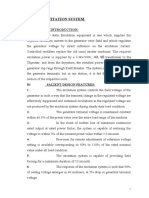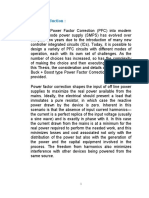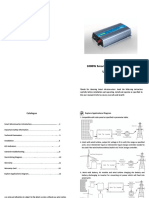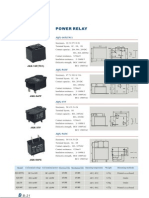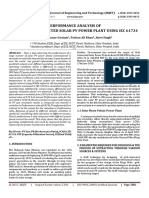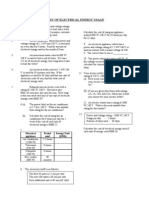Basic Power Factor Correction
Power Factor Correction is a frequently misunderstood topic. Improper techniques can result in overcorrection, under-correction and/or harmonic resonance.
presented by sh kok
�Basic Power Factor Correction What are the different types of loads?
Ohmic loads Lighting bulbs Iron Resistive heating
Inductive loads Electrical Motors Transformers Reactors/chokes Overhead lines Under excited Synchronous generators Discharge lamps Power electronic
Capacative loads Capacitors Underground cables Over excited synchronous generators
presented by sh kok
GRID
�Basic Power Factor Correction
Three different types of loads: 1. OHMIC-LOADS
Ohmic loads U and I in phase Phase shift = 0 No penalty
The voltage and current are said to be in phase ( = 0) and the entire input power is converted into active power. Thus, resistive circuits have a unity power factor.
I - Current
In resistive circuits the voltage and current waveforms reach their peaks and troughs as well as the electrical zeros at the same instant of time.
=0
The ohmic resistance does not depend on frequency.
U - Voltage
presented by sh kok
�Basic Power Factor Correction
Three different types of loads: 2. INDUCTIVELOADS
Inductive loads U is 90 ahead of I 90 phase shift Penalty!
Most of the industrial loads are inductive in nature e.g. motors, transformers etc. Due to inductive reactance of the load, the current drawn by the load lags behind the voltage waveform electrically by an angle .
U - Voltage
=90
The magnitude of is proportional to the inductive reactance. Since the current lags behind the voltage, inductive loads are said to have a lagging power factor. Impedance-XL = 2 * 3.14 * f * L
I - Current
presented by sh kok
�Basic Power Factor Correction
Three different types of loads: 2. INDUCTIVELOADS
Phase shift
Inductive loads cause
a phase shift between
Current
+ ve
Power
+ ve
current and voltage.
A positive as well as a
negative power can be observed.
U, I and power
-ve
Voltage
presented by sh kok
�Basic Power Factor Correction
Three different types of loads: 3. CAPACITIVELOADS
Capacative loads I is 90 ahead of U 90 phase shift Over compensation is risky!
I - Current
Due to capacitive reactance of the load, the current drawn by the load is ahead the voltage by an angle . The magnitude of is proportional to the
capacitive reactance.
=90
Impedance
U - Voltage
1 1 XC C 2 f C
presented by sh kok
�Three different types of electrical power
Reactive Power ( kvar) Q S 2- P2 Q2 QC Q1
S = Apparent Power
P = Active Power
Q = Reactive Power
Active Power P S - Q [ KW ] 2
2 1 S Apparent Power S P + Q [ kVA ]
cos = P/S sin = Q/S Q = S sin Q = P tan
= phase displacement angle S1 = uncompensatedapparent power S2 = compensated power with capacitors for compensation
presented by sh kok
�What is Active Power?
The amount of input power which is converted into output power, is termed as active power and is generally indicated by P. The active Power is defined by the following formula.
[W]
Ideally, entire input power i.e. apparent power should get converted into the useful output, i.e. heating of an oven, movement of an motor, light of an bulb.
presented by sh kok
�What is Reactive Power?
Electrical machines work on the principle of conversion of electromagnetic energy.(e.g. electric motors, transformers). A part of input energy is consumed for creating and maintaining the magnetic field. This part of the input energy cannot be converted into active energy and is returned to the electrical network on removal of the magnetic field. This power is known as reactive power Q and is defined as follows.
Q 3 U I sin
[VAr]
presented by sh kok
�What is Apparent Power?
Applications of electrical equipment are based on conversion of
electrical energy into some other form of energy. The electrical
power drawn by an equipment from the source is termed as Apparent Power, and consists of active and reactive power. The current measured with a clamp amp indicates the apparent power. It is defined as follows:
S 3 U I
[VA]
presented by sh kok
�What is the power factor?
Power factor = cos cos-phi = P (kW) / S (kVA)
Phase shift
Power
Category
Typical uncompensated PF
Current
U, I and power
+ ve
+ ve
-ve
Voltage
Breweries Cement plant Compressor Cranes Data Centre - Computer Drying-Plants Hospitals Machinery, big sized Machinery, small sized Office Building- General Plywood Sawmill Steel factory Suggar Tobacco Water pumps Welding transformer
0,6..0,7 0,6..0,7 0,7..0,8 0,5..0,6 0,8..0,9 0,8..0,9 0,7..0,8 0,5..0,6 0,4..0,5 0,7..0,8 0,6..0,7 0,6..0,7 0,6..0,7 0,8..0,85 0,6..0,7 0,8..0,85 0,4..0,5
presented by sh kok
�Power Factor Correction
presented by sh kok
�What is the power factor?
presented by sh kok
�Why to improve the power factor?
Reduction of power bill (short pay back time: 6-18 month usually) Reduction of ohmic losses Power Quality improvement (harmonics, voltage sags..) Higher kW loading of transmission and distribution equipment and/or smaller dimensioning of this equipment (cable, transformer, bus bars..)
presented by sh kok
�Why to improve the power factor?
Industrial. Commercial and domestic customers want to get most effective electrical installation to serve their machinery. Low PF can mean extra losses and penalty payments to utility for excessive reactive power. Power production and transmission companies would like to sell as much active power as possible to their customers. Low PF can reduce the generating and transmission capacity.
presented by sh kok
�Why to improve power factor?
presented by sh kok
�Why to improve the power factor?
What does this mean in reduced losses and save energy? The losses in the power line, transformers , and cables are proportional to the square of the current. Assume the average load on the 55kW is 35kW, then motor current is 65A. The AC drive input current under this condition is 60A The AC drive reduces the input current from 65A to 60A. The reduction of losses is described:
If the losses on the supply side are 5% of the average load, the AC drive can reduce these losses to about 4%.
presented by sh kok
�Why to improve the power factor?
presented by sh kok
�Why to improve the power factor?
presented by sh kok
�How to improve the power factor?
PFC Capacitors (HV or LV, automatic or fixed)
Reduce amount of inductive load
Over-excited synchronous generators
presented by sh kok
�Power Factor Correction
presented by sh kok
�Principle of Power Factor Correction
0 65 95
Mechanical or thermal work
Active Energy
Current Current
Reactive Energy
Generation of magnetic field
Supply
Load Capacitor
presented by sh kok
�Principle of PFC
S1
S2
QC Q 1
Q2 = Q1 - QC
P
S = Apparent Power
P = Active Power Q = Reactive Power
presented by sh kok
�Methods of PFC
Individual compensation
Group compensation Centralised automatic compensation
presented by sh kok
�Methods of PFC: 1. Individual (fixed) Compensation
presented by sh kok
�Methods of PFC: 1. Individual (fixed) Compensation
Advantages at a glance
kvar produced on the spot Reduction of line losses Disadvantages Many small capacitors are more
expensive that one central one * Low utilization factor of Reduction of voltage drops capacitors or equipment not often in operation Saving of regulator
presented by sh kok
�Methods of PFC: 2. Group Compensation
Advantages at a glance
Reduction of capital investment
Loses reduced in distribution lines Voltage drops reduced in distribution lines Higher utilization factor of capacitors
presented by sh kok
�Methods of PFC: 3. Centralized Compensation
controller
presented by sh kok
�Methods of PFC: 3. Centralized Compensation
Advantages at a glance Best utilization of the capacitors Most cost effective solution Easier supervision Automatic control
In factories with many loads of different output and operating times fixed compensation is usually too costly and non-effective. The most economic solution for complex applications is usually a centralized automatic capacitor bank, controlled by a automatic PF controller. Point of connection is usually in the main distribution panel close to the transformer.
presented by sh kok
�Methods of PFC: Summary
presented by sh kok
�Example of power factor correction calculation
HV Grid
Transformer 630 kVA, uk = 5 %
M 3~
300 kW cos = 0.65 Capacitor bank Qc = ?? kvar
Question: A building with a total load of 300 kW shows an actual power factor of 0.65 The customer asks for a target PF=0.96 What capacitor output is required to avoid surcharges for low PF?
presented by sh kok
�Example of power factor correction calculation
Solution: Qc = P * K) = 300*(0.88) = 252 kvar
For a proper fine tuning of the target PF, a capacitor bank design:
25 + 50 + 50 + 50 + 50 + 50 kvar
Depending on types of loads, e.g. frequency converters, de-tuned
capacitor banks should be used
presented by sh kok
�Example of power factor correction calculation
Office Building
TCL = 1200kW
?
M M M SSB 1 SSB 2
presented by sh kok
�Example of power factor correction calculation
Ic = kVAR / system voltage Qc = 2 x 3.14 x 50Hz x Cp x V2
presented by sh kok
�Example of power factor correction calculation
MCCB = 1.5 X Reactive Current
CONTACTOR = AC-6b RATING
presented by sh kok
�Example of power factor correction calculation
presented by sh kok
�Power factor correction at motor
presented by sh kok
�Voltage rise
presented by sh kok
�Voltage rise
presented by sh kok
�Remember Capacitor has losses
presented by sh kok
�Utilization Category
presented by sh kok
�Utilization Category
presented by sh kok
�PF Capacitor Inrush Current
presented by sh kok
�PF Capacitor Inrush Current
presented by sh kok
�PF Capacitor Inrush Current
presented by sh kok
�Contactor for Switching
presented by sh kok
�Power factor capacitors various brands
presented by sh kok
�Power factor capacitor specifications
High over current loading possible Longest life cycle: 115 000 hours Highest ambient temperature, up to 55 Highest impulse current: 300 * In No Corona effect Highest safety by Triple Safety System Highest reliability
presented by sh kok
�Power factor capacitor specifications Highest impulse current withstand capability: > 300 * In
4000,0 3000,0 2000,0 Current [A] 1000,0 0,0 -1000,0 -2000,0
Inrush current of app. 3500 A by energizing a PFC capacitor with 20 A rated current!
5 steps parallel
-3000,0 73,2
73,8
74,5
75,1
75,7 Time [ms]
76,3
77,0
77,6
presented by sh kok
�Power factor capacitor specifications
presented by sh kok
�Power factor capacitor Installation
presented by sh kok
�Power Factor - Metering
presented by sh kok
































